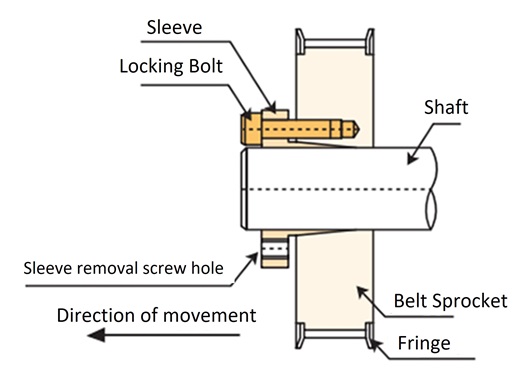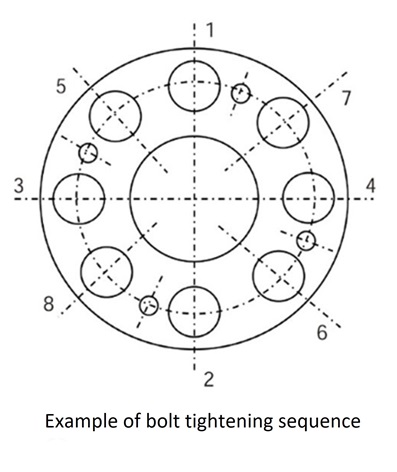Technical Data Synchronous Belts / Belt Sprockets Handling
Handling instructions (Lock Belt Sprockets S Type・S Type Plated)
Mounting
- 1) For S type
Wipe off the dirt on the shaft surface and apply a small amount of oil or grease. (Avoid using the oil or grease that contains molybdenum-based antifriction agent.)
Remove the locking bolt of the sleeve, wipe the contact surfaces of the belt sprocket and sleeve clean, and apply oil or grease
Also, apply it to the thread and seat parts of the locking bolt. Be sure to apply oil or grease to ensure stable bolt tightening force.
If not applied, it will result in insufficient transmission torque and loosening of bolts. - 2) For S type with plating
Completely wipe off any dirt or oil from the shaft surface. Remove the locking bolts and wipe the contact surface between belt sprocket and sleeve clean.
Do not apply oil or grease because it is not required.
In addition, special coating has been applied to the bolts in advance to achieve the same effect as applying oil or grease, so please do not apply any additional coating. - 3) Lightly tighten the locking bolts to tentatively assemble the sleeve.
- 4) Lightly push Lock Belt Sprockets tentatively assembled in 3) to the specified position by hand.
- 5) Tighten the bolts uniformly in the diagonal order at the torque that is one-fourth of the rated tightening torque MA.
- 6) Increase the tightening torque to the half of MA and tighten in the same manner as the step 5.
- 7) Raise the tightening torque to the rated value and tighten in the same manner as 5) and 6).
- 8) Tighten all the locking bolts at the rated tightening torque sequentially in a circumferential direction. Repeat this procedure several times.
When all the locking bolts are tightened at the rated tightening torque, the installation is completed.
Precautions for installation
- ・Be sure to use a torque wrench when tightening the locking bolts. Observe the tightening procedure and the tightening torque MA when tightening them. Tightening with a wrench other than a torque wrench or hand-tightening will result in incomplete installation, and lead to accidents such as slipping or deformation.
- ・Tightening bolt with a torque higher than the tightening torque may cause bolt damage. In addition, tightening the bolts at a torque lower could cause loosening of the bolts. Therefore, be sure to tighten at the appropriate tightening torque MA.
- ・Never use bolts other than those provided with this product as tightening bolts. Otherwise, bolts may damage and cause accidents. Contact us if you need a new bolt due to lost or replacement.
Removal
- 1) After confirming that no load, such as torque, is applied to the belt sprocket and shaft, loosen the locking bolts sequentially to remove them.
- 2) By inserting the removed bolts into the removal screw holes and tightening them uniformly, the locked state is released.
Movement of the belt sprocket when tighten bolts
In the installation of the Lock Series S Type, the sprockets are moved by 0.5 to 1.0 mm in the shaft direction between the initial fixation and the final tightening.
Therefore, when centering the product, consider the amount of movement of the belt sprocket in advance.
For the direction of movement of the belt sprocket, refer to the figure on the right.

General precautions
- 1) Allowable transmission torque :Load torque should be selected so that the maximum generated torque multiplied by the service factor is always less than or equal to the transmission torque.
- 2) Shaft diameter tolerance and surface roughness :The shaft diameter tolerance and shaft surface roughness shall be h8 and Ra 3.2, respectively.
- 3) Mounting to shafts provided with keyways or notched shafts
If the product is installed onto a shaft on which a keyway has already been machined, such as a motor shaft, or a D-shaped shaft, the allowable transmission torque decreases by 10%. - 4) Mounting to cold finished carbon steel bars
If the product is installed onto a cold-finished steel bar whose mechanical properties are guaranteed (allowable radius of drawing materials: Grades 8 to 10), the allowable transmission torque decreases by 10%. - 5) Ensure that the shaft is a solid shaft using S35C grade or higher steel.
- 6) Operating Temperature Range :-15℃~80℃(Aluminum :0℃~50℃)
- 7) Be sure to use a torque wrench when tightening bolts.
(Use the torque wrench properly in accordance with the instruction manual of the torque wrench used. )
(Un-plated Aluminum) Bolt and tightening torque MA
| Sleeve frame No. | Bolt size | Bolt tightening torque N・m {kgf・m} |
|---|---|---|
| S1 | M4x16 | 4.2 {0.43} |
| S2 | M5x18 | 8.3 {0.85} |
| S3, S4 | M5x20 | |
| S5 | M5x22 | |
| S6 | M6x25 | 16.8 {1.71} |
| S7 | M8x30 | 40.5 {4.13} |
(Plated) Bolt and tightening torque MA
| Sleeve frame No. | Bolt size | Bolt tightening torque N・m {kgf・m} |
|---|---|---|
| S1 | M4x16 | 3.4 {0.35} |
| S2, S3, S4 | M5x20 | 6.8 {0.69} |
| S5 | M5x25 | |
| S6 | M6x25 | 13.6 {1.39} |
| S7 | M8x30 | 32.8 {3.35} |


